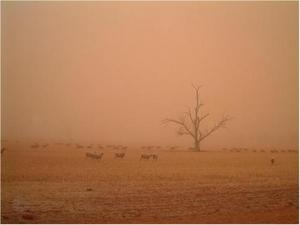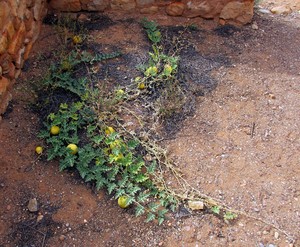We have just spent the weekend in Dorset and yesterday morning our car, like many others, was covered in Saharan dust. It’s no surprise that disease spores can travel hundreds or even thousands of miles if larger dust particles can move with such ease.
Whilst driving back last night, I noticed smoke initially rising from a bonfire and then, rather than spreading out, it travelled ribbon-like horizontally a few metres above the ground before eventually falling back to the ground some distance away. This is typical of temperature inversion that can occur on still evenings after a warm spring day. Such conditions can strongly suppress the dispersion of not only smoke but also other particles such as pesticides.
The condition is called inversion because the air gets warmer rather than cooler with height (i.e. it is the inverse of what typically occurs). In the UK, it is more likely to take place in the spring during the evening and night when the air after a sunny day is warmer than that just above a rapidly cooling ground and there is little wind to mix up these layers.
My first practical experience of this was one April when spraying plots. Spray opportunities were rare and we had to take the opportunity to spray at dusk. The day had been warm and sunny but windy. Towards dusk the wind dropped completely and so we sprayed. As I finished the final plot, I turned round to see some of the spray just hovering above it. What proportion I’m not sure but the treatment worked. However, even a small proportion of the spray moving elsewhere is not desirable.
The largest incident in the UK of inversion causing problems with spray drift was in 1979. Brittox, a product mix of bromoxynil, ioxynil and mecoprop esters, dominated spring broad-leaved weed control in cereals. Again it was a difficult spring for spraying and opportunities to do so were limited to late evening and early morning. The result was widespread damage to oilseed rape. On many occasions the oilseed rape in the adjoining field was untouched but a rape crop further away in the same direction could have discrete patches of damage. This eventually was pinned down to vapour of the mecoprop ester being ‘trapped’ by inversion and moving above the adjoining crop before coming down on a crop further away.
There were two implications arising from these experiences. Firstly, esters of mecoprop were withdrawn and replaced by the less volatile salt formulations. Secondly, the enthusiasm for spraying at night came to an abrupt halt. Tramlines had been introduced in the 1970s and after a few difficult springs, many farmers were contemplating using them to guide the spraying operation at night in order to take advantage of low wind conditions. However, the implicit danger from inversion meant that the problems of spray drift could be higher than when spraying in windier conditions during the day.
The UK is less prone to inversion than some other countries. A few years ago I was travelling with a crop consultant in Australia when his phone rang. A farmer wanted to know how to kill wild melons (they are inedible) in the summer fallow period. He wanted an alternative to glyphosate and the initial advice was 2-4,D. However, almost as an afterthought, the consultant asked how far it was between the paddock (field!) to be sprayed and the nearest vineyard. Apparently, at that time of the year, there had to be a buffer area of 35 kms (yes 35 kms!) between spraying 2-4,D and vineyards. Contamination of vineyards (and potentially wine) by herbicide spray drift in inversion conditions remains a major issue in Australia.
The farmer wanted to kill the wild melons and other green vegetation because h e was trying to store as much water as possible in the soil to maximise the supply to the autumn sown crops. When I first worked in Australia there were two schools of thought on this issue. The first, and the one which now prevails, is that all vegetation between the harvest of one crop and the sowing of the next should be destroyed using herbicides and the previous crop stubble left undisturbed to prevent wind erosion. The alternative traditional approach had been to cultivate regularly to a shallow depth. The argument for that was not just to prevent vegetation from establishing but also to stop capillary flow of water to the surface layers.
e was trying to store as much water as possible in the soil to maximise the supply to the autumn sown crops. When I first worked in Australia there were two schools of thought on this issue. The first, and the one which now prevails, is that all vegetation between the harvest of one crop and the sowing of the next should be destroyed using herbicides and the previous crop stubble left undisturbed to prevent wind erosion. The alternative traditional approach had been to cultivate regularly to a shallow depth. The argument for that was not just to prevent vegetation from establishing but also to stop capillary flow of water to the surface layers.
The second view has not only been proved inferior, in terms of water storage in the soil, but also it encourages frightening levels of wind erosion. I remember sitting in a plane at Melbourne Airport just over 10 years ago after witnessing a huge amount of cultivation and consequential wind erosion the day before. The amount of red dust in the air was drowning out much of the daylight and I was genuinely concerned that the jet engines would be blocked. After that a sprinkling of Saharan dust seems trivial.

